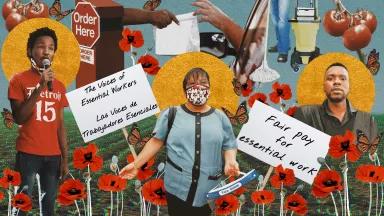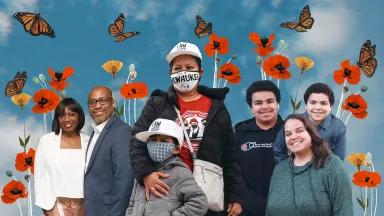When the World Stopped, These Essential Workers Started Their Engines
In Part Three of our “Pandemic at Work” series, a bus driver, airline custodian, and Uber driver reflect on their year “helping to keep the cogs of society rolling.”

The “Pandemic at Work” series explores the work environment in the era of COVID-19 through the voices of those trying to survive through it.
When the World Health Organization (WHO) declared the outbreak of the novel coronavirus a pandemic a year ago today, businesses shuttered, events were canceled, and schools and offices closed. The world seemed to stop—except it didn’t.
Over the year, ridership on public transit, such as the New York City subway, has fallen considerably—but less so in low-income areas, where many essential workers live and continue to rely on it daily. Across the country, throughout the ebb and flow of infection and unemployment rates, people were on the move to grocery stores, hospitals, and any number of essential workplaces. And month after month after month, transportation workers helped them get there—at great risk to themselves.
Thousands of public transit operators have fallen ill with COVID-19, hundreds with fatal infections. Additionally, grounded flights, increased sanitation protocols, and shrunken revenues have taken a toll on the industry. Hundreds of thousands of workers have gotten laid off, been furloughed, or have had their shifts (and income) severely cut. When they are able to work, the mask requirements that protect them also put them on the receiving end of a lot of flak from unruly passengers.
Just days before the pandemic relief measures passed in December were set to expire, Congress sent another lifeline to struggling Americans, parents, caregivers, hard-hit businesses, and stretched local governments. And today, President Joe Biden signed the $1.9 trillion coronavirus relief bill into law. Among other much-needed aid, the relief package, called the American Rescue Plan, allocates $90 billion in transportation and infrastructure support.
Below are the stories from three transportation workers who have been trying to deliver passengers safely—whether by bus, plane, or car—during a pandemic that’s left around 10 million people in the country out of work and 530,000 dead.
Steve Soliz, Michigan
Steve Soliz has been helping people get from point A to point B in Lansing, Michigan, for more than three decades. The 54-year-old married father of two says being a bus driver is “my calling.”
Even a year fraught with danger, uncertainty, and other challenges hasn’t soured him on life behind the big wheel.
“What I like best is the tangible help you give people every day, taking them to work, school, appointments, etc.,” says Soliz. “You develop friendships with people who ride your bus route on a regular basis, and after a number of years, you feel like you contributed to helping them more than just by providing transportation.”
His least favorite part of the job: The unpredictable shifts and the unruly passengers—a problem the pandemic has amplified.
“There’s occasions where I have to deny a ride to a customer who doesn’t have a mask, and who then gets very upset with me. It’s led to physical threats, being cussed at, even spit at,” says Soliz, who has been working for the Capital Area Transportation Authority since 2018.
This U.S. Army veteran is also the president of the Amalgamated Transit Union (ATU) Local 1039. So far, COVID-19 has claimed the lives of 136 members of the ATU, the nation’s largest union for public transit, intercity, and school bus drivers. Soliz himself fell ill last summer. After a brief stay in a hospital in early August, he spent the next two months fighting the virus at home, returning to work on October 11.
“It was a long battle to recovery—daily prayers and constant worry,” says Soliz.“I’m not personally concerned about where I’m going when I take my last breath, but while I’m here, we all have a job to do and a service to perform. We’re here to help people get to work and to school and essential workers get to their jobs. And I aim to do it to the best of my ability.”
ATU recently applauded the CDC’s decision to make masks mandatory on public transit and has been at the forefront of demanding other COVID-19 protections for transit workers. They’ve championed everything from safeguard barriers to air filtration systems to passenger limits. The union also supported the $28 billion in grants to transit agencies included in the latest COVID relief package.
“Now let’s hope the agencies use the money as it’s intended—to avoid layoffs, keep service on the street, and provide hazard pay,” says Soliz.
“We are caring, essential workers providing a vital service for all of us out here,” he says. “We’re happy to do the work. We just ask for some semblance of recognition from the public that it’s dangerous for us right now. Do your part. Mask up. Social distance. Help us to keep the cogs of society rolling.”
Danny Villalobos, Illinois
Danny Villalobos has worked for Scrub, a contract cleaning firm at Chicago’s O’Hare International Airport for nearly three years. The 58-year-old worker makes $15.96 per hour sanitizing airplane lavatories.
It was not his first choice of occupation.Villalobos completed two years of college before spending 22 years in manufacturing with Wesley-Jessen Corp., a pioneer of color contact lenses, where he earned a steady salary of $60,000. But when his job moved to Atlanta, he stayed in Chicago to remain close to his son, Alex. He spent the next nine years in linen service at a large hospital network before a round of layoffs in 2010 led to a post refueling planes at the airport. When he got laid off again, he found work running an after-school program for a social service agency, but he left in search of more full-time work. He couldn’t find any.
“That age discrimination they never talk about, because you can’t prove it, is real. Every time you apply somewhere, they say you’re overqualified.
That’s how I came to the job I have now, dumping shit from planes,” he says, chuckling. “I’m a joker. So I’ll say it in my words: I have a shit job.”
Still, Villalobos is thankful for the work after a year spent underemployed like so many others. The pandemic walloped his income. “The travel industry just went south. Flights were being cancelled. There were no more conventions. Business people weren’t traveling. And when business travel went down, so did work, because planes weren’t flying.”
Scrub began furloughing employees in February and then in March, slashed the shifts of those who remained. Villalobos’s weekly work schedule plummeted to 20 hours, and his representative at the Service Employees International Union Local 1 advised him to go on partial unemployment. In April, Villalobos was furloughed, but his company called him back to work later that month.
Villalobos lives in an apartment on the first floor of a two-level building owned by his 84-year-old father, Antonio, a Catholic deacon who raised eight kids in Humboldt Park. He’s his father’s caregiver and pays $750 a month in rent. Some days, Villalobos will work just 2.5 hours; other days, he’ll clock in four. Even if his hours get bumped to 30 a week, Villalobos would take home around $1,400 a month, but it would also mean he’d be ineligible for partial unemployment. Regardless, Villalobos says, after electric and gas bills, plus transportation expenses, he’s barely scraping by. “In this pandemic, we’re at the mercy of the company,” he says. “I’m not afraid anymore to go to a food shelter.”
Villalobos recently became a union steward to help fight for respect, protection, and fair pay he says is overdue to workers like him. “We’ve been working through this pandemic, putting ourselves in harm’s way every day, keeping the airport clean, making sure everything is sanitary inside and out, and that people are protected against this pandemic. We just ask to be treated fairly.”
The newly passed COVID relief bill provides $11 billion in grants to airports and aviation manufacturers and another $12 billion to help airlines and their contractors avoid layoffs. But so far, he says, the federal stimulus boost to airports and airlines has not been trickling down to workers.
“We know that these companies have been getting COVID relief monies, and we haven’t seen any of it, no kind of hazard pay during this whole thing,” Villalobos says. “God bless the nurses and doctors. But there are other people out here who don’t get any mention. We’re essential workers. We have gone unnoticed.”
Alex Miller, California
After spending 15 years testing computer software and 13 more teaching science in middle and high schools, Alex Miller made a break for the emerging ride-share industry.
“Teaching is a very stressful job. I eventually kind of burned out on it. I started doing ride-share driving to try it out and found I liked it. It’s kind of like a retirement job,” says Miller, who started driving for the three major ride-share companies—Lyft, Sidecar, and Uber—in 2014, eventually settling in with Uber.
“On a typical day, pre-pandemic, I’d gross about $150; on a good day, $200. So I was making between $55,000 and $75,000 a year,” he says. “You work long hours to get that money, about 12 hours. But it’s easy work.”
It wasn’t so easy, however, in the pandemic’s early months, when stay-at-home orders froze travel, shuttered businesses, prevented gatherings, and turned metropolises into ghost towns.
“It was terrible. Demand dropped tremendously. We were making less than minimum wage. I drove through February and March, and it slowly got worse,” says Miller. Sharing the close quarters of an automobile with several people each day also became increasingly dangerous. Sure enough, in April, Miller, who is 57 with underlying health conditions, came down with COVID-19. “I had a cough, and went and got tested. It was a mild case, a loss of sense of taste, diarrhea. I was off work for about a month.”
Back on the road in May, business picked up. Many drivers had quit to avoid contracting the virus, but thanks to the passing of the CARES act in March 2020, others were able to wait out the risk while collecting unemployment insurance for the very first time as gig workers, under the Pandemic Unemployment Assistance (PUA) program. With fewer ride-share drivers on the road, coupled with California’s statewide stay-at-home order beginning to loosen, more fares started coming Miller’s way.
Still, challenges remain. Before the pandemic, Miller’s least favorite aspect of his job was the drunk rider who would throw up in his car. These days, it’s the passenger who refuses to wear a mask. (Uber masking enforcement guidelines allow both a driver and a rider to cancel a ride if either is mask-less.)
“Once or twice a day, someone tries to get in my car without a mask. I tell them ‘I’m not going to take you anywhere.’ I’ve been called every name in the book. I get cursed out maybe every other day.”
Miller says drivers typically report such customers but wishes Uber and other ride-share companies had better ways to verify customers, since problem riders, whose accounts are deactivated, simply open new ones with different credit cards. He also thinks ride-share companies should pay unemployment insurance for their drivers, independent contractors though they may be, so that drivers won’t have to depend on the passages of temporary measures like the PUA.
Miller knows his job is hazardous—especially in hard-hit Los Angeles County, where the virus has so far claimed the lives of about one in 500 people.
“This is a very dangerous job because of COVID-19,” he says. “But at least I already have antibodies. And of course, I am ready to get the vaccine the minute I am eligible.”
This NRDC.org story is available for online republication by news media outlets or nonprofits under these conditions: The writer(s) must be credited with a byline; you must note prominently that the story was originally published by NRDC.org and link to the original; the story cannot be edited (beyond simple things such as grammar); you can’t resell the story in any form or grant republishing rights to other outlets; you can’t republish our material wholesale or automatically—you need to select stories individually; you can’t republish the photos or graphics on our site without specific permission; you should drop us a note to let us know when you’ve used one of our stories.




The Particulars of PM 2.5
What Is the Justice40 Initiative?
Air Pollution: Everything You Need to Know